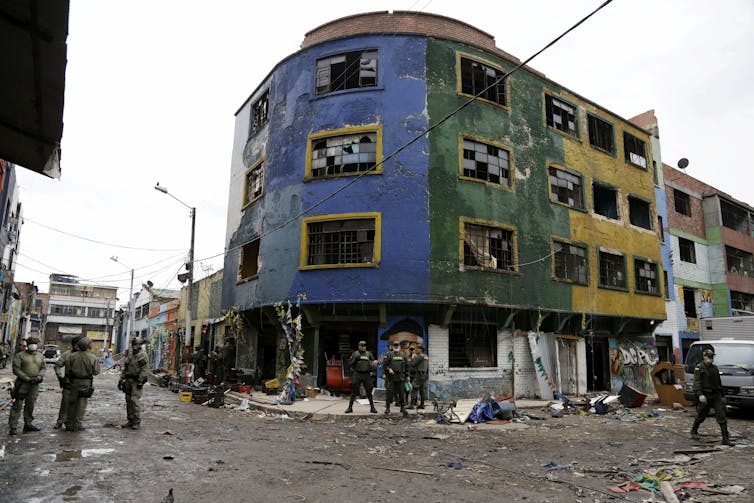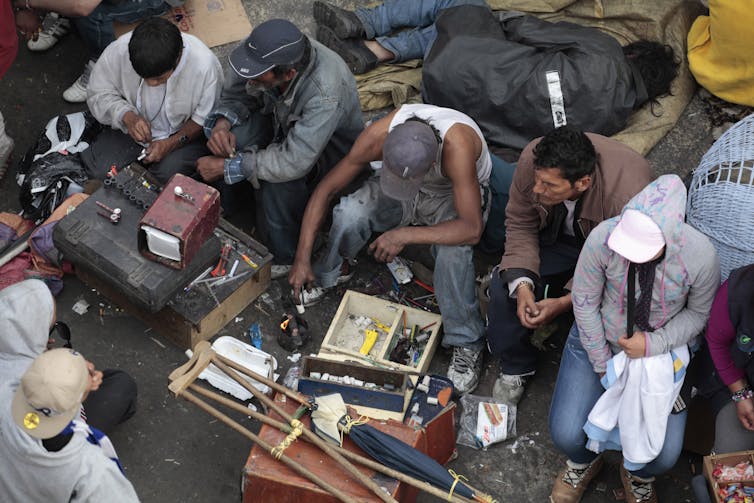
It was prior to heavy traffic on Aug. 23, 2017, when the Bogota, Colombia, district cops and SWAT team came for the gangs of El Cartuchito, a location with a powerful illegal drug trade and open intake of bazuco, a drug acquired comparable to split. Outfitted in anti-riot equipment and equipped with batons and tear gas, authorities were sent out in, the city's Department of Security later on tweeted, to "recover" the location "for the residents."
That was the spin. In practice, the authorities really left not simply the drug gangs however likewise individuals guilty of absolutely nothing unlawful, specifically homeless individuals, individuals who utilize bazuco and trash pickers. These activities, if socially discredited, are not criminal activities in Colombia, consisting of the belongings of drugs for individual usage
After by force getting rid of everybody from El Cartuchito, the cops offered citizens a plastic snap-on bracelet, enabling them to go back to the area.
The raid was simply the current aggressive operation to "tidy up" Bogota. According to the city's Department of Security, in 2016 there were 15 such raids on 3 "ollas," or outdoor drug scenes. Mayor Enrique Peñalosa, who got in workplace in 2016, firmly insists that the crackdowns are a public security requirement since Bogota's ollas have actually ended up being "operating centers for the mob" where kids undergo "enormous sexual exploitation."
It's real that Bogota deals with a genuine security obstacle in locations like El Cartuchito, where murder rates are acutely high Along with other scientists, I've been talking with individuals in the ollas for many years about how the city might keep citizens, consisting of homeless kids, much safer It's clear to me that a method of violent displacement followed by financial investment and gentrification is not the response.
Uncovering the 'olla'
The El Cartuchito raid was moderate compared to what Peñalosa's administration let loose in 2015 in a location called El Bronx. In May 2016, SWAT groups robbed the downtown streets in the middle of the night, signed up with by kid protective services and other city firms.
Rousing sleeping homeless citizens, typically strongly, authorities assembled a minimum of 2,000 individuals(quotes differ commonly) and herded them into trucks, headed to a concealed place.
Those who declined to go were slowly eliminated of the location, initially into a plaza, then into surrounding ollas and, ultimately, into a canal bed on Sixth Street.
There, cops kept numerous individuals included for weeks. During the night, Bronx banishes informed me, the officers would form a cordon to keep them from leaving the canal. Every 3rd night, according to statements, authorities required this group to go up or down the canal, obviously arbitrarily. I invested a night in the canal and saw the containment-and-sleep-deprivation technique firsthand.
During one huge rainstorm, several homeless people were gotten rid of; one was later on discovered dead
Two regional human rights companies, CPAT and PARCES, whose May 2017 joint report information the ruthless treatment of El Bronx locals, submitted a problem versus Peñalosa's administration in the Inter-American Human Rights Court. The case is pending.

Just prior to the Bronx crackdown, in May 2016, the city had actually likewise cleared the Carrilera shantytown, burning down cardboard houses and taking apart shacks "What are they doing? The federal government is running over on bad individuals, on homeless individuals!" one witness stated in an interview with El Espectador paper. "They provided us no options, like a location to go, a location to live."
Peñalosa's motto is "Bogotá, Better for All." all these raids have made numerous marvel: Is Bogota truly for everybody?
The right to the city
This argument about who belongs in cities is longstanding. As the feminist geographer Melissa Wright has actually composed, elite city slickers typically relate development with the disappearance of specific social groups who, in their eyes, deteriorate public area.
In 1990 s-era New York City, Mayor Rudolph Giuliani punished "lifestyle criminal offenses" like prostitution More just recently, the brand-new mayor of São Paulo, Brazil, João Doria, took down a significant downtown fracture scene and homeless encampment
Such efforts, in some cases called damaged windows policing, show a belief that, to enhance security and city development, "unwanted" individuals and low-level criminal activities need to vanish.
In Brazil, the constitution acknowledges the citizenry's right to the city, so a number of city companies have questioned the legality of Doria's raids.
Colombians have no such constitutional right, and information determining Bogota's homeless population are obsolete and insufficient(a census of street occupants is arranged to start in October).
People surviving on the streets of the capital consistently deal with harassment and cops aggressiveness The Cartuchito and Bronx raids drove homeless homeowners and sex employees from the ollas, where most Bogota homeowners never ever saw them, and spread them (in addition to the bad guys who ran in the ollas) throughout this city of 8 million.
Many individuals did not invite their brand-new next-door neighbors, the bulk of whom are active drug users Residents submitted problems, and there were reports of " contributed" food being poisoned
But urbanists and scholars have actually long acknowledged the right of every resident to inhabit public area. In an influential 2008 short article in the journal The New Left, the geographer David Harvey composed that this is "among the most valuable yet most overlooked of our human rights."

The right to the city was likewise a style of in 2015's United Nations Habitat III conference, which concentrated on establishing a "brand-new metropolitan program" for the world.
There's no fast repair for metropolitan inequality, however there are methods to promote development in cities while appreciating the rights of the most marginalized. Programs that provide social services, healthcare, real estate and work can assist change the lives of drug users. In the meantime, damage decrease services like needle exchange and peer education can minimize dangerous habits.
In a report on El Bronx launched on Sept. 27 by the University of the Andes' Center for the Study of Security and Drugs, the scientists consider what state-sponsored treatment alternatives would be lawfully feasible in Colombia and suggest checking out speculative health techniques customized to the requirements of Bogota's bazuco users.
Such efforts were beginning to get underway in previous mayoral administrations, and from 2012 to 2016 the city run mobile university hospital for drug users in El Bronx. Peñalosa rapidly phased out these tasks.
Everyone ousted from El Cartuchito, El Bronx, and other "recovered" locations share something: they are all street-connected, indicating that their everyday activities happen mainly in public. In rejecting such individuals their right to the city, Bogota authorities are basically rejecting them their right to exist.
Read More https://futurenewsforyou.com/news/who-are-the-real-targets-of-bogotas-crackdown-on-crime/?feed_id=176&_unique_id=63b2d4ef77457
Niciun comentariu:
Trimiteți un comentariu